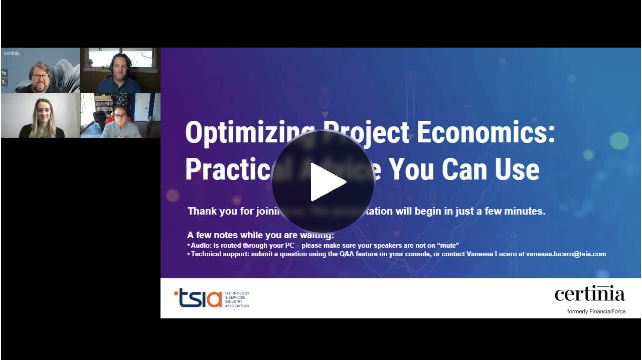Optimizing project economics: Four key metrics for success
 This article is written by Joe Thomas, Solutions Evangelist for Certinia. His goal is to help organizations understand the “how and why” cloud-based technology can help them run a most intelligent, agile, and connected business. Get his insights here on project economics and some key metrics that will help you optimize.
This article is written by Joe Thomas, Solutions Evangelist for Certinia. His goal is to help organizations understand the “how and why” cloud-based technology can help them run a most intelligent, agile, and connected business. Get his insights here on project economics and some key metrics that will help you optimize.
The world of professional services is a dynamic one and successful project management is a constant balancing act. It’s not just about delivering quality services; it’s also about optimizing your project economics to ensure profitability and client satisfaction.
I recently had the pleasure of moderating and participating in a lively webinar discussion about optimizing project economics with some folks who seemed to have mastered the process. There were several light bulb moments but one that really stood out was the importance of monitoring certain key metrics early in the project lifecycle so you can steer the project toward success right out the gate.
First, let’s clarify how we’re defining project economics. It’s basically a set of Key Performance Indicators (KPIs) and data inputs that provide near real-time insight into project performance. These factor in both a blended rate per hour and project profit margins. Data inputs include things like: billable timecard revenue, fixed fee revenue, hours from timecards, hours from future assignments, and miscellaneous adjustments.
But much of this changes over the course of a project from bid to delivery and it’s important to stay on top of it. Below, I share four key metrics that will hopefully guide your professional service organization to stay on course, preserve margins, and ultimately achieve your desired outcomes. For a deeper dive into optimizing your project economics, check out the webinar discussion in its entirety below.
1. Projected metrics: a proactive approach to success
Very quickly after the inception of a project, professional service firms must ask themselves: “Are we on track?” or “Are we off track?” These questions set the tone for proactive project management. Projected metrics, which are estimates based on initial planning and forecasts, offer a roadmap for project teams. They provide a benchmark against which actual performance can be measured. Constantly monitoring projected metrics helps teams spot deviations early and take corrective actions promptly.
For instance, if the initial timeline estimates suggest a project should be halfway complete by a certain date, monitoring the progress against this projection can reveal if the project is falling behind schedule, even in the initial days. By identifying these issues earlier than that halfway point, project managers can make informed decisions, allocate additional resources, or adjust project scopes to keep the project on track. This proactive approach is instrumental in preserving margins by avoiding costly delays and overruns.
2. Actual metrics: foundation of data-driven decisions
While projected metrics provide a framework, actual metrics are the bedrock of project economics. These metrics are derived from what has been physically accomplished on the project. They include data points such as timecards logged by team members, approved milestones, and expenditures. By contrasting actual metrics with their projected counterparts, organizations can gain a precise understanding of how well they are executing their projects.
For example, if the projected budget estimated a certain amount of expenses by a given point in the project, comparing this with actual expenditures reveals whether the project is within budget. This insight allows organizations to control costs and allocate resources judiciously, ultimately safeguarding profit margins.
WATCH WEBINAR: Optimizing Project Economic: Practical Advice You Can Use

3. Timecards and resource utilization: efficiency matters
In professional services, time is money. Timecards, which record the hours worked by team members on specific tasks, are invaluable tools for measuring resource utilization. Monitoring timecards not only ensures that employees are engaged in billable work but also highlights areas where resource allocation can be optimized.
Consider a scenario where an employee consistently logs fewer billable hours than expected. By analyzing this data, managers can identify potential bottlenecks, skill gaps, or workflow inefficiencies that may be hindering productivity. This granular view of resource utilization enables organizations to make informed decisions on resource allocation, improving efficiency and, in turn, enhancing project economics.
4. Approved milestones: tracking progress and quality
Milestones are critical checkpoints in any project. They represent key deliverables or stages that must be achieved. Monitoring approved milestones is essential for gauging project progress and ensuring that quality standards are met.
If a project has reached a milestone that includes client review and approval, tracking this milestone’s status becomes pivotal. Timely approvals ensure that projects continue smoothly and do not encounter unnecessary delays. Furthermore, milestone tracking helps teams maintain client satisfaction by demonstrating progress and accountability.
Professional service firms can’t afford to leave project economics to chance. By diligently monitoring these four essential metrics – projected metrics, actual metrics, timecards and resource utilization, and approved milestones – organizations can navigate the complexities of project management with confidence. But don’t just take my word for it, watch the webinar and hear how your peers are successfully optimizing their project economics with Certinia!





